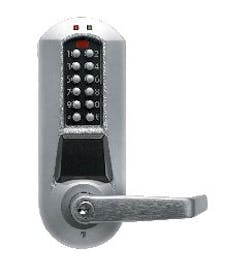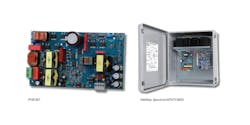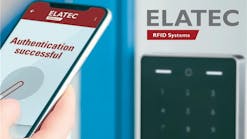In the beginning, there were the battery operated electromechanical locks. You entered a code into the keypad and if the code was correct, the lock unlocked, permitting retraction of the latch bolt. Over time, additional credentials were introduced, including card-based magnetic stripe, bar code, ferromagnetic and onto proximity, biometric and smart.
Soon after standalone electromechanical locks were introduced, audit trail and date/time functions were added. To retrieve the audit trail, a person had to physically go to each device and retrieve the information using either an infrared printer, data transfer module or handheld Personal Digital Assistant (PDA). Most of these retrieval devices are manufacturer and some are even model specific.
The next major step was the development of hardwired networked locks. A network allows sharing of information between the locks and the computer, providing the ability to have more users, more powerful options for controlling access and more complete audit trail information.
Networked locks can be divided into two categories: manufacturer specific operating system and software and “open architecture” technology allowing the lock to be operated by any software operating within the lock’s parameters.
Hardwiring provides the potential benefit of real time communication between the computer and the locks, which do not have to be battery powered since wiring is being run and power is only two more wires. When any instructions are programmed at the computer, the affected locks can be updated almost instantaneously. Hardwired networked locks can provide real time audit trail and door status. Networking eliminates the need to program, upload or download changes and audit trails at each lock.
The difficulty with hardwired networked locks is if there is a very long wire run or if there are problems with running wires, costs can be extremely expensive. For example, problem buildings include having reinforced concrete walls, if trenching is required or there is no space above the ceilings.
Hardwired networked locks provide the ability to immediately delete a user, employee or service provider’s credential that has been terminated or lost. A system wide lockdown can be performed on case of an emergency. The lockdown command will usually override all existing programming functions until the emergency no longer exists.
Wireless
Continuing on the development path, a number of electromechanical lock manufacturers cut the network wires and became wireless while still providing the lock functionality. The lock’s wireless protocol determines the standard (for example 802.15.04, 802.11, 900MHz, 915MHz, etc.), network size, transmission range, data rate, system resources, and average battery life.
Wireless locks include the Corbin Russwin Access Intelligent Wi-Fi Locks, Kaba Access Control E-Plex Series products with wireless capabilities and the Sargent Profile Series v.N2 with Aperio™ Technology. The Sargent Profile Series v.N2 locking devices connect wirelessly between the Aperio hub mounted directly above the opening and the lock. Kaba Access Control E-Plex Wireless Series offer a variety of credentials including proximity cards and DESFire, Mifare, iClass Smart cards.
A wireless electromechanical lock contains a wireless transceiver that communicates with a wireless gateway (node or hub) in place of the wiring. The gateway can be wired to the computer using a standard RJ45 Ethernet connection or wireless using 802.11 B/G. Wireless gateways will have a specified range, which can vary by manufacturer and product line.
The wireless signal between the gateways and the locking devices varies depending upon the lock manufacturer’s specifications. For example, Salto uses the low power radio 802.15.04 receivers operating at 2.4Ghz encrypted with a range of up to 100 feet. Alarm Lock Networx gateways operating at 900MHz span up to 900 feet clear field range. SimonsVoss universal plug and play network radio operates at 915 MHz for wireless transmission, the range is up to 100 feet.
To expand the range of a wireless network, wireless repeaters can be strategically placed to enlarge the gateway’s signal area in order to reach around barriers or door at a greater distance. A wireless repeater receives and retransmits the signal, so the signal can cover longer distances or distances that have signal obstacles such as reinforced concrete and large metallic objects.
Note: Wireless devices connected through wireless repeaters can operate at a level of decreased efficiency. This may or may not have an effect on the overall operation of the locks.
Two styles of wireless locks have evolved - complete electromechanical locks and components that are mounted onto standard mortise locks. Electromechanical locks have different configurations. Several different manufacturers’ product photos appear in this article including Alarm Lock Networx locks, Sargent Profile Series v.N2 and Kaba E-Plex Wireless lock. The latest SimonsVoss wireless networked lock, the SV1C, looks like a mechanical cylindrical lock with wireless access control built in.
The SimonsVoss digital wireless electronic SV1C lock is capable of supporting up to 64,000 users, has a 3,000-transaction audit trail and a 150,000-operation battery life. The SV1C is a lock capable of working standalone, as part of a real-time network or as part of a virtual network. The SimonsVossSV1C installs into standard door prep.
Mortise cylinder and trim-based wireless network components provide the functionality to control access. A variation on the standard key-in-lever and mortise lock is the wireless locking technology being installed into the exterior trim. For example, Salto XS4 Series trim-based electronics can be installed onto doors equipped with ANSI spec mortise lock bodies.
Most wireless network locks are battery operated or have the ability to operate on hardwire power. A battery-powered lock must operate with a specific amount of “sleep time” or the batteries would be consumed within a short time period. This “sleep time” is when the lock is not active. This time is usually adjustable. The longer the “sleep time”, the longer the battery life. During “sleep time,” locks do not accept most programming and operational commands. Hardwired locks do not require “sleep time”.
Some manufacturers have a secondary wakeup protocol that actives communication enabling the locks to receive a “lockdown” command in case of an emergency during “sleep time.”
When an electromechanical lock awakes, it can send and receive packets of information that keep the lock and the system up-to-date. When a lock is awake, interaction with the system takes place. Awake time can be multiple times per minute or once or twice a day. The more awake times, the smaller the packets of information can be making the time awake shorter.
Depending upon the manufacturer, the wireless network accommodates up to a specified number of wireless networked locks or locking devices.
Depending upon the needs and practicalities, many facilities incorporate both wired and wireless locking devices into a single network. For example, a large facility that has both exterior and interior access control requirements can use wired network locking devices on the exterior doors and wireless networked locking devices on the interior doors.
Schlage AD-Series electrified locks have a plug-in modular electronic platform containing a reader module and a communication module. The existing modules can be removed and different modules installed, reconfiguring the lock without having to replace the entire lock. The AD-Series configurations can include manually program, standalone or networked communications with wired or wireless locks. Locks can be equipped with one, two or three credential readers.
Installations
Test the wireless system’s design prior to installation of any locks. A reinforced concrete or metal wall can obstruct a signal. A wireless test kit can test the operating frequency and signal environment in order to determine communication strength for wireless applications. Knowing the locations for the locks and using a test kit can make the placement of the gateway and/or the need and placement of repeaters most efficient.
The Salto RF Kit is comprised of a transmitting and receiving device that operates on 802.15.04, the communication protocol that Salto wireless products use. The TESTER transmits an RF test signal and the Device Under Test (DUT) is designed to receive the test signal. The TESTER should be located in the exact location for the gateway or repeater.
When the TESTER is powered, a signal with a frequency of ten pulses per second a solid red LED illuminates indicates it is sending. When the DUT is powered, it will flash a red LED for every signal received. Place the DUT within close range of the TESTER. Count the number of red flashes per second to be sure it is ten. Place the DUT in the exact location for the lock or locking device. If the DUT flashes ten times per second the reception is good. Poor reception is less than ten flashes per second. If the reception is poor, the TESTER needs to be repositioned until ten flashes per second are counted.
Schlage’s TK400 test kit for the AD-Series consists of a wireless portable signal tester and a panel interface module. This enables the locksmith to verify the 900 MHz signal strength between each lock and interface modules (gateways) by reading the LED lights indicating the quality of the signal.
Wireless locks are available with a broad range of Radio Frequency IDentification (RFID) credential technologies. Building upon the proximity technology, the Smart cards and multi-standard capabilities are an attempt to increase the levels of security. Some examples of Smart cards and multi-standard RFID Technologies include MIFARE, DESfire, Picopass, Legic and HID iClass.
Security comes with a price. The higher the level of security, the more expensive the technology is. A proximity card is inexpensive today. However, it was very expensive not to long ago. The latest RFID credentials are the smart cards (and the multiple standards smart cards) and Near Field Communications (NFC), a short range (contactless) technology that can be incorporated into “smart” phones in order to interact with an access control system to gain access. The “smart” phone becomes the employee badge and behaves like a contactless card.
Before purchasing hardwired or wireless electromechanical locks, find out about the requirements for buying and installing specific products. For example, ASSA ABLOY requires persons who install integrated Weigand products, IP enabled products and Aperio to become a Certified Integrator. Other companies may have similar requirements or minimum purchase (dealer) agreements.
All wireless products are software driven. Some lock manufacturers offer a variety of software options. Others offer only one. Some of the manufacturer’s software is designed for just about every conceived application. Some available software is just basic. Choosing the correct software for your application is probably more important than choosing the locking devices.
When installing a wired network, all signals travel through wires, most companies base security on physical access control. Limit access to computers and the wired network to trusted individuals.
A wireless network or a wired/wireless network has its own security issues. Unlike wired connections, wireless signals travel throughout a building (and usually beyond) making it theoretically possible for individuals to connect to the network without authorization. Encryption is the most common solution as most modems and access points have built-in encryption. Does the software offer any additional security?
When looking into software, make sure your specific application will be supported today and in the projectable future. Determine the number of user codes, types of credentials, lock hardware supported, scheduling support and audit trail capabilities prior to the installation and the projected numbers for one to five years.
For example, Alarm Lock software downloads are free, and free training videos can be downloaded in two formats: low bandwidth and DSL/Cable. Alarm Lock provides free technical support.
Note: Most lock manufacturers that I spoke to for this article do not offer technical support to the end user.
FMI
Lock manufacturers discussed in this article include:
Alarm Lock. Telephone: 631-789-4871. Web Site: www.alarmlock.com
Corbin Russwin Architectural Hardware. Telephone: 800-543-3658. Web Site: www.corbinrusswin.com .
Kaba Access Control. Telephone: 336-725-1331. Web Site: www.kabaaccess.com.
Salto Systems Inc. Telephone: 866-467-2586. Web Site: www.salto.us/index.php
Sargent Lock. Telephone: 800-727-5477. Web Site: www.sargentlock.com.
Ingersoll Rand Security Technologies. Telephone: 866-322-1237. Web Site: www.schlage.com/ad-series
SimonsVoss Technologies, Inc. Telephone: 414-421-2481. Web: www.simons-voss.us






